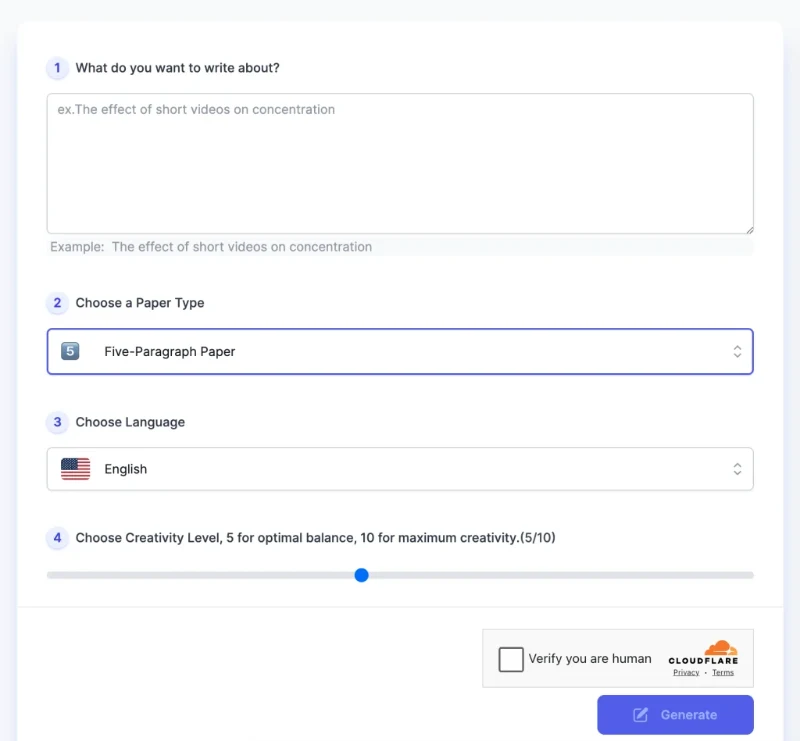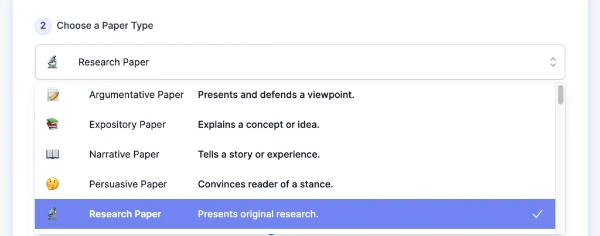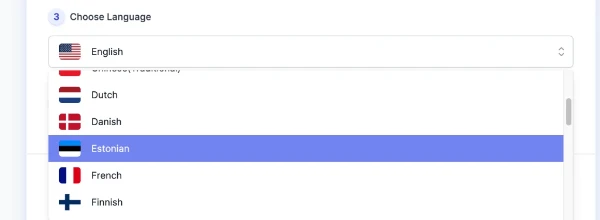Free AI Tools. No Sign-Up Required. Full Access.
AI Paper Writer Generator
Step into the future of paper writing with AI Paper Writer Generator. Harness the power of advanced AI to craft top-tier content.
Combine the current tool with these other tools to work more efficiently.
Discover other tools with functions and purposes similar to the one you are currently viewing.
Discover the tools most favored and highly-rated by users on our website.
Explore more AI tools in these related categories
AI tools that generate, or optimize written articles and content for various purposes.
AI Writing tools generate, or enhance text content for various writing tasks.
AI tools designed to assist with research, studying, writing, and academic data analysis tasks.
If you encounter difficulties while writing a paper, unsure of how to proceed, our AIFreeBox AI Paper Writer Generator is the ultimate guide for you.
This page will guide you through what the AIFreeBox AI Paper Writer Generator is, the types of papers it can create, and how to use our tool for your writing needs. Additionally, we’ll provide a step-by-step guide to help you quickly and easily get started.
What Is the AI Paper Writer Generator?
This is a free tool that simplifies writing academic papers, essays, and reports by using AI. It analyzes topics using natural language processing and machine learning to create text and recommend sources. Designed for students, researchers, and professionals, it enhances writing quality and efficiency.
Key Features
- Free Online Access: No cost for using the tool.
- AI-Driven Writing Assistance: Uses artificial intelligence to help generate paper.
- Natural Language Processing: Understands and generates paper based on the input topic.
- Source and Data Suggestion: Recommends relevant sources and data for inclusion in the content.
- Efficiency and Quality: Aims to save time while improving the quality of written work.
- Versatile Application: Useful for students, researchers, and professionals across various fields.
How To Use the Free Paper Writer AI: Step-by-Step Guide

Step 1. Topic Selection
- In the first field, type in the specific topic you want to write about.
Step 2. Paper Type

Choose the type of paper you require from the dropdown menu, such as a research paper.
Step 3. Language Choice

- Select the language in which you want the paper to be written.
Step 4. Creativity Level
- Adjust the creativity slider to your desired level, between 5 for balanced and 10 for maximum creativity.
Step 5. Captcha Verification
- Complete the CAPTCHA to verify you’re human.
Step 6. Generate
- Click the ‘Generate’ button to create your paper.
A Variety of Paper Types for Your Writing Needs
The AIFreeBox AI Paper Writer supports a variety of paper types, tailored to meet diverse writing requirements.
- 📝 Argumentative Paper: Engages in a debate, presenting reasons for and against an issue to convince the reader of a particular stance.
- 📚 Expository Paper: Provides an analysis or explanation of a specific topic, presenting information with evidence and facts.
- 📖 Narrative Paper: Recounts a personal or fictional experience or tells a story in a structured and literary manner.
- 🤔 Persuasive Paper: Aims to persuade the reader to accept the writer’s point of view or recommendation.
- 🔬 Research Paper: Investigates and reports on original research conducted by the author, often including a hypothesis, data analysis, and findings.
- 🏫 Admission Paper: Usually a personal statement or essay submitted as part of an application process, reflecting the applicant’s qualifications and aspirations.
- 🔍 Analytical Paper: Breaks down an idea or issue into key components, examining each piece in detail.
- 👤 Biography Paper: Narrates the life of a person, detailing their experiences, achievements, and impact.
- ⚖️ Cause and Effect Paper: Explores the causes of certain events and discusses their consequences.
- ↔️ Compare & Contrast Paper: Highlights the similarities and differences between two or more subjects.
- 🌈 Descriptive Paper: Uses vivid language to describe a person, place, thing, or event, creating a picture in the reader’s mind.
- 🔄 Dialectic Paper: Presents a logical argument by asserting, counter-arguing, and refuting to explore a truth through reasoned argument.
- 🌟 Evaluation Paper: Critically assesses a subject, event, or work, often including the writer’s judgment.
- ✅ Exemplification Paper: Provides examples to turn abstract ideas into concrete understanding for the reader.
- 🧭 Exploratory Paper: Investigates a problem or examines an idea or experience from all angles.
- 5️⃣ Five-Paragraph Paper: A classic essay structure with an introduction, three body paragraphs, and a conclusion.
- 🏰 Historical Paper: Analyzes and interprets events from the past and examines their impact and significance.
- 💬 Informal Paper: Characterized by a relaxed, conversational tone, often used for personal reflection.
- 🎤 Interview Paper: Centers around the transcript of one or more interviews, presenting insights and discussions.
- 📚 Literature Paper: Critically examines and interprets a piece of literature or literary theme.
- 🤚 Opinion Paper: Expresses the writer’s personal viewpoint or perspective on a subject.
- 🧩 Problem-Solution Paper: Identifies a problem and proposes one or more solutions.
- ⚙️ Process Paper: Describes the steps of a process, enabling the reader to understand or replicate the procedure.
- 👥 Profile Paper: Delivers a comprehensive and descriptive profile of a subject, such as a person, group, or organization.
- 🤲 Reflective Paper: Personal reflection on the writer’s experiences, exploring their growth and development.
- 💭 Response Paper: Provides the writer’s reaction and detailed analysis of a text or experience.
- 🎬 Review Paper: Offers a critical assessment of a work of art, such as a book, film, or painting.
- 📢 Rhetorical Analysis Paper: Examines the techniques used in a text to persuade and influence readers.
- 🎓 Scholarship Paper: Written with the intent of convincing an organization to grant a scholarship.
- 🔖 Summary Paper: Condenses the main points or arguments of a larger work into a concise overview.
- 🧬 Synthesis Paper: Combines information from different sources to create a cohesive understanding of a topic.
- 🌍 Thematic Paper: Focuses on a particular theme or motif, exploring it in depth.
- 👁️🗨️ Visual Analysis Paper: Analyzes the form, content, and context of visual media.
Tips for Using AI Paper Generator Tool
- Be Specific with Your Topic: Provide a clear and precise topic to guide the AI in generating relevant content.
- Set the Correct Paper Type: Select the appropriate type of paper to ensure the structure matches your needs.
- Adjust Creativity Level: Play with the creativity settings to strike a balance between conventional and novel content.
- Review and Edit: Use the generated draft as a starting point and refine it to meet your personal or academic standards.
- Use Suggestions: Incorporate suggested sources and data to enrich your paper and support your arguments.
- Iterate: Don’t hesitate to generate multiple drafts to explore different angles or depths of analysis for your topic.
FAQs
What types of papers can AIFreeBox AI Paper Writer generate?
Our AIFreeBox Paper AI tool supports 33 various paper types including argumentative, expository, narrative, persuasive, and more.
Is AIFreeBox AI Paper Writer free to use?
Yes, it is a free online tool.
Can I select different languages for my paper?
Our paper writing tool allows you to choose from supported languages for your paper.
How does the creativity level affect my paper?
Adjusting the creativity level changes how innovative or traditional the content will be.
Does the AI tool require user input to generate content?
Yes, you need to provide a topic and other requirements for the tool to generate content.
Can I use the content generated by AIFreeBox AI Paper Writer directly?
It’s recommended to review and edit the content to ensure it meets your specific needs and standards.
How does the tool ensure the content is relevant to my topic?
The AI uses natural language processing to analyze your topic and create pertinent content.
Is there a limit to how much content I can generate?
No, it is free and unlimited to use.